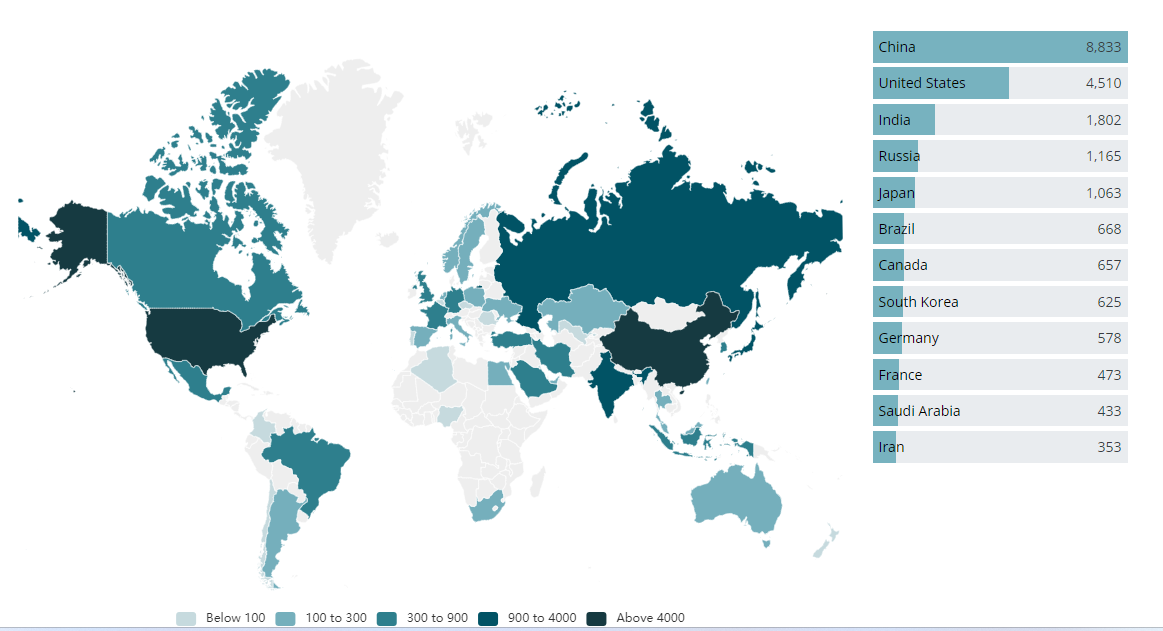According to the “2023 World Energy & Climate Statistics – Yearbook” released , the total power generation capacity of the world’s countries and regions expanded to a record high of 2,916,510,000,000,000 kilowatt-hours (kWh) in the year 2022, but the growth rate slowed to 2.3 per cent, less than 40 per cent of the previous year’s rate. However, the growth rate slowed to 2.3%, less than 40% of the previous year’s growth rate.
China’s global share of power generation, has exceeded 30%
On a country-by-country basis, China’s power generation in 2022 was 88,487 billion kWh, up 3.7 per cent year-on-year, boosting its global share to 30.34 per cent – already more than 30 per cent – and continuing to lead the world in thermal, hydropower, wind and solar power generation.
China’s nuclear power generation capacity in 2022 is 417.8 billion kWh, once again surpassing France to take 2nd place globally; nuclear power generation is ranked first globally by the United States with 812.1 billion kWh in 2022; and France is 3rd with 294.7 billion kWh of nuclear power generation.
Although France’s nuclear power generation has fallen to the world’s third place, but France’s existing nuclear power plants in the “installed capacity of nuclear power units” is still above China; France’s total electricity, nuclear power accounted for as high as 63 per cent, is also far more than China, and in the world’s major nuclear energy use of the country’s leadership.
However, the number of nuclear power units under construction and to be built in China ranks No. 1 in the world. The International Atomic Energy Agency (IAEA) released a report earlier this year showing that as of March 2023, the number of nuclear reactors under construction in the world is 56. Among them, 22 nuclear reactors under construction belong to China.
Not only that, but China has proposed a construction programme for a whopping 46 nuclear reactors. If successfully completed, it is expected to catch up with the United States around 2050, thus becoming the world’s largest country in terms of nuclear power generation.
Russia is fourth, with 223.7 billion kilowatt-hours of nuclear power in 2022; South Korea is fifth with 176.1 billion kilowatt-hours of nuclear power; Canada is sixth with 86.6 billion kilowatt-hours of nuclear power; and Spain is seventh with 58.6 billion kilowatt-hours of nuclear power.
Eighth place is Japan, with 51.8 billion kWh of nuclear power generation in 2022.After the Fukushima nuclear accident in 2011, Japan’s nuclear power plants were shut down for a while. But with thermal power generation unable to effectively fill the gap and oil and gas prices at high levels, nuclear energy is back again.
The report published by BP shows that the United States will generate 45,477 billion kWh of electricity in 2022, a year-on-year increase of 3.3 per cent, with the global share rising back to 15.59 per cent; third place goes to India, with an electricity generation capacity of about 1,858 billion kWh, a year-on-year increase of 8.4 per cent, with the global share rising to 6.37 per cent.
While China, the U.S. and India boosted their global share, Russia and Japan both saw their share slip. Among them, Russia’s power generation was 116.69 billion kWh, only a slight increase of 0.9%, the global share fell to 4.0%; Japan’s power generation was 1,033.6 billion kWh, an increase of 1.4%, the share fell to 3.54%.
Brazil’s 2022 generation was 677.2 billion kWh, Canada’s 659.6 billion kWh, South Korea’s 620.3 billion kWh, Germany’s 577.3 billion kWh and France’s 467.7 billion kWh. Of the top ten, only Germany and France saw a contraction in power generation.
After the outbreak of the Russian-Ukrainian conflict, a number of European countries followed the pace of the United States, are proposed to significantly reduce the dependence on Russian energy. Nuclear power, wind power, hydropower and can not effectively fill the “coal, oil and natural gas power generation” loss, the result can only be a decline in energy production.





